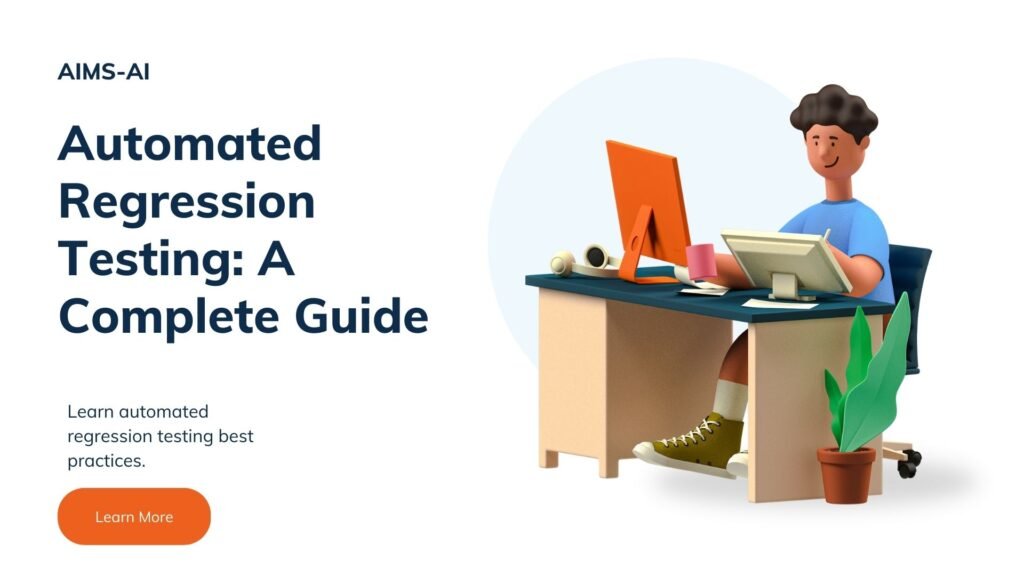Automated Regression Testing: A Complete Guide
What Is Automated Regression Testing?
Automated regression testing involves running a suite of test cases to ensure that recent changes to code—whether new features, bug fixes, or updates—don’t disrupt existing functionality. By automating these tests, developers can save time, reduce errors, and maintain the software’s integrity.
Why Is Automated Regression Testing Important?
-
- Faster Feedback Loop
In traditional manual testing, it can take days or weeks to verify changes. Automated regression testing provides instant feedback, allowing teams to address issues early in the development cycle.
- Faster Feedback Loop
-
- Cost Efficiency
While setting up automation can involve upfront costs, it significantly reduces repetitive manual efforts, lowering costs in the long run.
- Cost Efficiency
-
- Improved Accuracy
Automation eliminates the risk of human error, ensuring consistent results even when tests are repeated frequently.
- Improved Accuracy
-
- Scalability
As software grows, the test suite can scale with it. Automation tools can handle thousands of test cases without compromising performance.
- Scalability
Benefits of Automated Regression Testing:
-
- Enhanced Productivity
Automated testing frees up developers and testers to focus on more strategic tasks, like creating new features or addressing critical issues.
- Enhanced Productivity
-
- Better Test Coverage
Automation tools can execute a wide range of test cases, ensuring all aspects of the application are tested. This is especially important for complex applications with multiple components.
- Better Test Coverage
-
- Reusability
Once an automated test case is created, it can be reused across multiple test cycles, saving time and effort.
- Reusability
-
- Continuous Integration and Delivery (CI/CD) Support
Automated regression testing is crucial for CI/CD pipelines, ensuring every code change is tested before deployment.
- Continuous Integration and Delivery (CI/CD) Support
Popular Tools for Automated Regression Testing:
To implement automated regression testing, you need the right tools. Some widely-used options include:
-
- Selenium: A powerful open-source tool for web applications. visit website
-
- TestComplete: Ideal for both web and desktop applications. visit website
-
- JUnit: A Java-based framework for unit and regression testing.
-
- Katalon Studio: An all-in-one platform for beginners and experts.
Each tool comes with its own strengths, so the choice depends on your project’s requirements and budget. For a detailed comparison, check out this guide on automation tools.
Best Practices for Automated Regression Testing:
-
- Prioritize Test Cases
Not all tests need automation. Focus on high-priority tests that cover critical functionalities.
- Prioritize Test Cases
-
- Use Version Control
Maintain test scripts in a version control system like Git to track changes and collaborate effectively.
- Use Version Control
-
- Run Tests Frequently
Integrate automated tests into your daily workflow, running them after every code change or at regular intervals.
- Run Tests Frequently
-
- Monitor Test Performance
Over time, automated tests may become outdated or slow. Regularly review and update test scripts for optimal performance.
- Monitor Test Performance
-
- Leverage Data-Driven Testing
Use real-world scenarios and datasets to improve test reliability.
- Leverage Data-Driven Testing
Challenges in Automated Regression Testing:
While automation offers numerous advantages, it comes with challenges:
-
- Initial Setup Costs: Building the automation infrastructure requires time and resources. However, the long-term benefits often outweigh these costs.
-
- Maintenance: Test scripts need regular updates to align with changes in the application.
-
- Complexity in Dynamic Applications: Highly dynamic applications may require advanced techniques to create stable test cases.
To overcome these challenges, consider partnering with experienced QA professionals or exploring resources like this comprehensive QA guide.
Real-World Example: Automated Regression Testing in Action:
Let’s consider an e-commerce application. With frequent updates, such as new payment gateways or promotional features, regression testing ensures that existing workflows—like adding items to the cart or processing payments—aren’t disrupted. Automation tools like Selenium can simulate user interactions, verify expected outcomes, and ensure the application runs smoothly.
Conclusion
Automated regression testing is more than just a trend; it’s a necessity for modern software development. By saving time, reducing costs, and improving test coverage, it empowers development teams to deliver reliable, high-quality software.
If you’re new to automation, start small with open-source tools like Selenium. For more advanced needs, consider integrating paid tools that offer comprehensive features and support.
For further insights, explore our detailed guide on getting started with automated testing. Ready to optimize your testing strategy? Let’s dive in!

